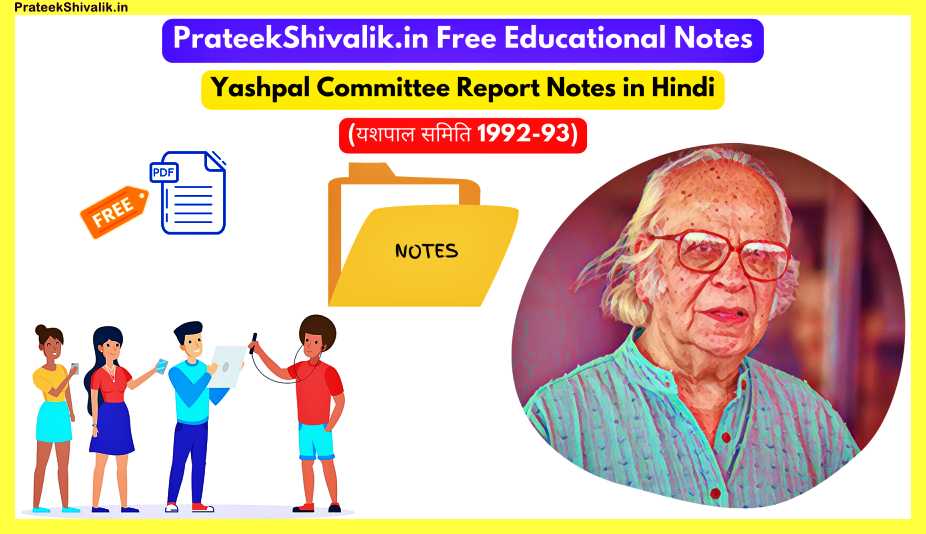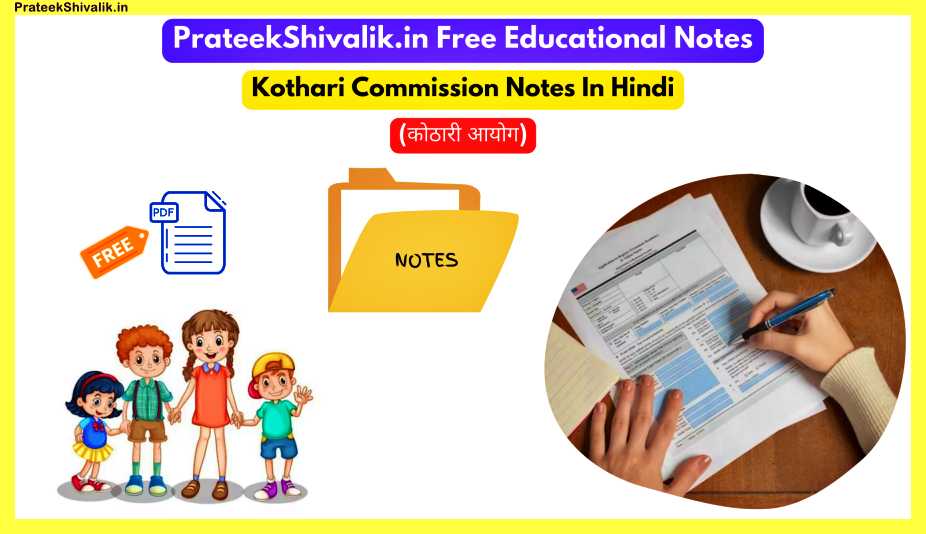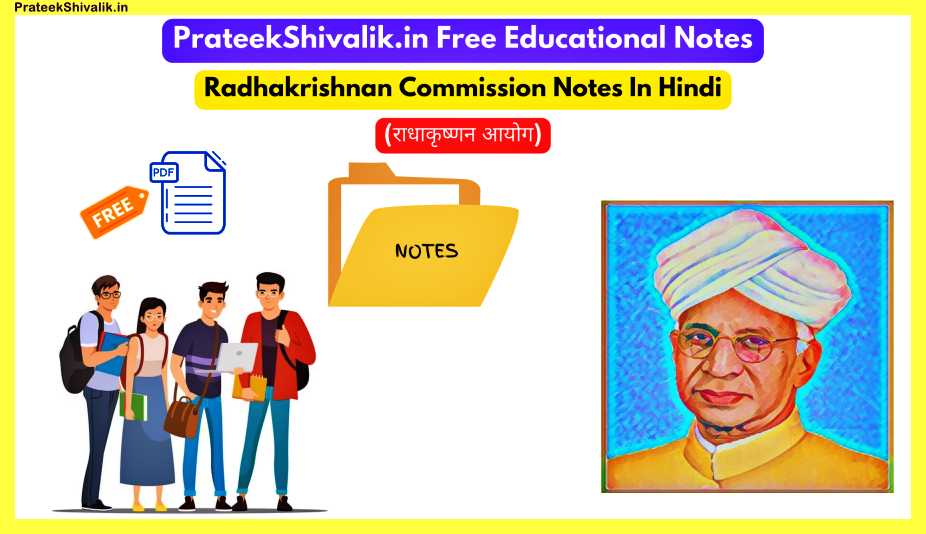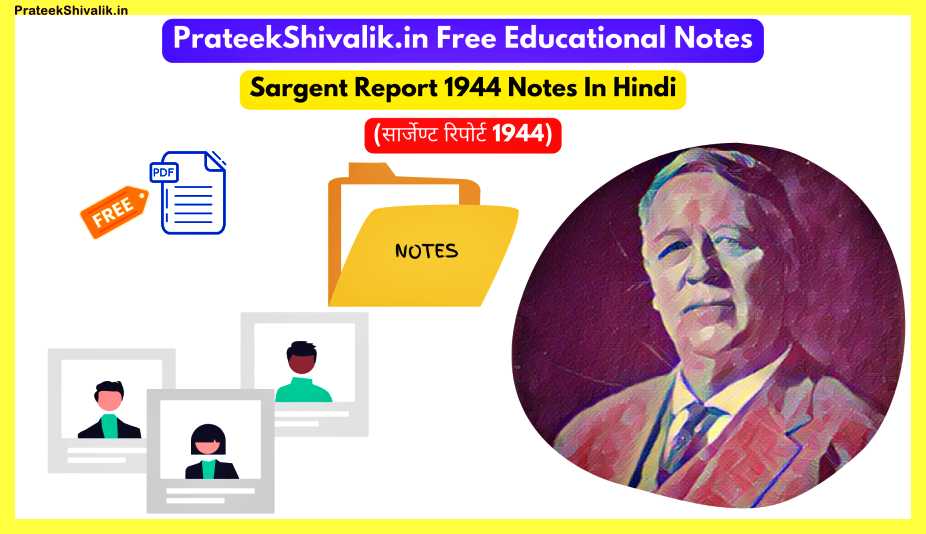Yashpal Committee Report Notes in Hindi
आज हम आपको (Yashpal Committee Report) के सम्पूर्ण नोट्स देने जा रहे हैं | Yashpal Committee Report Notes in Hindi (1992 – 1993), (Yashpal Committee Report) के नोट्स पढ़कर आप अपना कोई भी टीचिंग एग्जाम पास कर सकते हैं | तो चलिए जानते हैं इसके बारे में बिना किसी देरी के |
Yashpal Committee
(यशपाल समिति 1992-93)
- The Government of India set up a ‘National Advisory Committee’ in the year 1992 to reduce the educational burden of school students.
(विद्यालयी विद्यार्थियों के शैक्षणिक भार को कम करने के लिए भारत सरकार ने वर्ष 1992 में एक ‘राष्ट्रीय सलाहकार समिति’ का गठन किया ।) - Professor Yashpal, former head of UGC, was appointed the chairman of this committee; Therefore, this committee was known as Yashpal Committee.
(यूजीसी के पूर्व प्रमुख प्रोफेसर यशपाल को इस समिति का अध्यक्ष नियुक्त किया गया; इसलिए इस समिति को यशपाल समिति के नाम से जाना गया ।) - The committee had to consider how to reduce the burden on students at all levels of education, especially the primary level. Also, how to improve the quality of education.
(समिति को यह विचार करना था कि शिक्षा के सभी स्तरों, विशेषकर प्राथमिक स्तर पर विद्यार्थियों पर शैक्षणिक बोझ को कैसे कम किया जाए और साथ ही शिक्षा की गुणवत्ता में सुधार कैसे किया जाए ।) - This committee carefully inspected the syllabus and textbooks produced and practiced by NCERT and CBSE, as well as the syllabus and textbooks prevalent in different provinces of the country.
(इस समिति ने NCERT और CBSE द्वारा निर्मित एवं प्रचलित पाठ्यक्रम एवं पाठ्यपुस्तकों के साथ-साथ देश के विभिन्न प्रान्तों में प्रचलित पाठ्यक्रम एवं पाठ्यपुस्तकों का ध्यानपूर्वक निरीक्षण किया ।) - It consulted school teachers, principals, chairman of education boards,’ students, parents, voluntary organizations engaged in innovations, course makers, course writers, private publishers and famous educationists of the country.
(इसने विद्यालय के शिक्षकों, प्रधानाचार्यों, शिक्षा बोर्डों के अध्यक्ष, विद्यार्थियों, अभिभावकों, नवाचारों में लगे स्वैच्छिक संगठनों, पाठ्यक्रम निर्माताओं, पाठ्यक्रम लेखकों, निजी प्रकाशकों और देश के प्रसिद्ध शिक्षाविदों से परामर्श किया ।) - Finally, on 15 July, 1993, the commission rendered its report titled ‘Learning without Burden’ to the government. In 1993, the Ministry of Human Resource Development (MHRD), Government of India, set up a National Advisory Committee with Yash Pal as its chairman to go into the issue of overburdening of school children.
(अंत में, 15 जुलाई, 1993 को आयोग ने भारत सरकार को ‘बोझ रहित अधिगम’ शीर्षक से अपनी रिपोर्ट सौंपी । 1993 में, मानव संसाधन विकास मंत्रालय (एमएचआरडी), भारत सरकार ने स्कूली बच्चों के अत्यधिक बोझ के मुद्दे पर जाने के लिए यश पाल के अध्यक्ष के रूप में एक राष्ट्रीय सलाहकार समिति की स्थापना की थी।)
Major Recommendations
(प्रमुख सिफारिशें)
The Yash Pal Committee of 1993 made several key recommendations regarding the education system. Some of these recommendations are highlighted below:
1993 की यशपाल समिति ने शिक्षा प्रणाली के संबंध में कई महत्वपूर्ण सिफारिशें कीं। इनमें से कुछ अनुशंसाओं को नीचे रेखांकित किया गया है:
- Decentralization of the curriculum development process and increased involvement of teachers.
(पाठ्यक्रम विकास प्रक्रिया का विकेंद्रीकरण और शिक्षकों की भागीदारी में वृद्धि।) - Establishment of education committees at the village, block, and district levels.
(गांव, ब्लॉक और जिला स्तर पर शिक्षा समितियों की स्थापना।) - Limiting the jurisdiction of CBSE to only KVs and Navodaya Vidyalayas, with all other schools being affiliated with the relevant state boards.
(सीबीएसई के अधिकार क्षेत्र को केवल केवी और नवोदय विद्यालयों तक सीमित करना, अन्य सभी स्कूल संबंधित राज्य बोर्डों से संबद्ध हैं।) - Abolition of interview tests and interviews for nursery admissions.
(नर्सरी दाखिले के लिए साक्षात्कार परीक्षा और साक्षात्कार की समाप्ति।) - Strengthening the norms for granting recognition to private schools to prevent commercialization.
(व्यावसायीकरण को रोकने के लिए निजी स्कूलों को मान्यता देने के मानदंडों को मजबूत करना।) - Elimination of the requirement for schoolchildren to carry heavy books to school.
(स्कूली बच्चों को स्कूल में भारी किताबें ले जाने की आवश्यकता को समाप्त करना।) - No homework for primary school students and non-textual homework for higher classes.
(प्राथमिक विद्यालय के छात्रों के लिए कोई गृहकार्य नहीं और उच्च कक्षाओं के लिए गैर-पाठ्य गृहकार्य।) - Reduction of the teacher-pupil ratio to a minimum of 1:30.
(शिक्षक-छात्र अनुपात को घटाकर न्यूनतम 1:30 करना।) - Increased utilization of electronic media in education.
(शिक्षा में इलेक्ट्रॉनिक मीडिया का बढ़ता उपयोग।) - Enhancing teacher training through various measures.
(विभिन्न उपायों के माध्यम से शिक्षक प्रशिक्षण को बढ़ाना।)
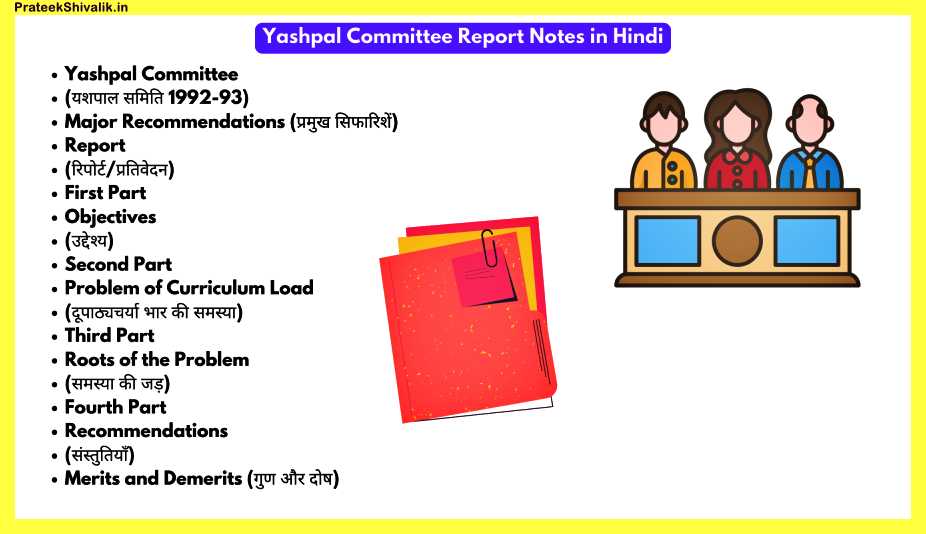
Report
(रिपोर्ट/प्रतिवेदन)
The report is divide into five parts, as follows:
(रिपोर्ट को पाँच भागों में विभाजित किया गया है, जो इस प्रकार है 🙂
- First Part – Objectives: It explains the objectives of the constitution of the committee, and discusses its method of working.
(पहला भाग – उद्देश्य: यह समिति के गठन के उद्देश्यों की व्याख्या और इसकी कार्यप्रणाली पर चर्चा करता है ।) - Second Part – Problem of Curriculum Load: It discusses the prevalent school education and its problems, and goes on to explain the terms ‘academic burden’ and ‘levels of education’.
(दूसरा भाग – पाठ्यचर्या भार की समस्या: यह प्रचलित विद्यालयी शिक्षा और इसकी समस्याओं पर चर्चा करता है, और ‘शैक्षणिक बोझ’ और ‘शिक्षा के स्तर’ की शर्तों की व्याख्या करता है ।) - Third Part: Roots of the Problem: It discusses the causes of the problems.
(तीसरा भाग: समस्या की जड़: यह समस्याओं के कारणों पर चर्चा करता है ।) - Fourth Part: Recommendations: It suggests solutions to the above problems.
(चौथा भाग: सिफारिशें : यह उपरोक्त समस्याओं के समाधान का सुझाव देता है ।) - Fifth Part: Appendix: It includes the orders under which the committee was constituted.
(पाँचवाँ भाग: परिशिष्ट: इसमें वे आदेश शामिल हैं जिनके अंतर्गत समिति गठित की गई थी ।)
First Part
Objectives
(उद्देश्य)
- To reduce the burden on students at all levels of education, especially the primary level.
(शिक्षा के सभी स्तरों, विशेषकर प्राथमिक स्तर पर विद्यार्थियों पर बोझ को कम करना ।) - To improve the quality of education.
(शिक्षा की गुणवत्ता में सुधार लाना ।)
Second Part
Problem of Curriculum Load
(दूपाठ्यचर्या भार की समस्या)
- Students are taught more but they learn or understand less.
(विद्यार्थियों को पढ़ाया ज्यादा जाता है लेकिन वो सीखते या समझते कम हैं ।) - The average weight of schoolbag in school primary classes is about 4 kg.
(विद्यालय की प्राथमिक कक्षाओं में विद्यालय बस्ते का औसत वजन लगभग 4 किलो होता है ।) - Children are forced, right from the beginning, to do homework, join tuition and different types of coaching classes; as a result, they have a little time for recreation.
(बच्चों को शुरू से ही गृहकार्य करने, ट्यूशन और विभिन्न प्रकार की कोचिंग कक्षाओं में शामिल होने के लिए
मजबूर किया जाता है; नतीजतन, उनके पास मनोरंजन के लिए थोड़ा समय है ।) - The curriculum and textbook material are not related to the real life of students.
(पाठ्यचर्या और पाठ्यपुस्तक सामग्री विद्यार्थियों के वास्तविक जीवन से संबंधित नहीं हैं ।) - Textbooks too are examination-oriented; they comprise information and data only.
(पाठ्यपुस्तकें भी परीक्षा-उन्मुख हैं; उनमें केवल जानकारी और आंकड़े शामिल है।) - Completing the curriculum has become the objective in itself, and the teachers are engaged in doing just this.
(पाठ्यक्रम को पूरा करना अपने आप में उद्देश्य बन गया है, और शिक्षक ऐसा करने में लगे हुए हैं।) - Classes are very large, curriculum is very heavy and textbooks are difficult.
(कक्षाएं बहुत बड़ी हैं, पाठ्यक्रम बहुत भारी है और पाठ्यपुस्तकें कठिन हैं ।) - As a result of these factors, teachers cannot pay attention to other aspects of education other than completing the curriculum.
(इन कारकों के परिणामस्वरूप, शिक्षक पाठ्यक्रम पूरा करने के अलावा शिक्षा के अन्य पहलुओं पर ध्यान नहीं दे सकते हैं ।) - The fear of examinations is intense on the children; both teachers and guardians contribute to this fear.
(बच्चों में परीक्षा का भय गहराता जा रहा है । शिक्षक और अभिभावक दोनों इस डर में योगदान करते हैं ।) - School education appears to be uninteresting, boring and bitter.
(विद्यालयी शिक्षा अरुचिपूर्ण, उबाऊ और द्वेषपूर्ण प्रतीत होती है ।) - Securing more marks in examinations has become a mark of ability, and students are
promoted to the next higher class on the basis of just this. As a result, children lay stress on learning by rote, rather than understanding.
(परीक्षाओं में अधिक अंक प्राप्त करना योग्यता का प्रतीक बन गया है, और विद्यार्थियों को इसी के आधार पर अगली उच्च कक्षा में पदोन्नत किया जाता है। नतीजतन, बच्चे समझने के बजाय रटकर सीखने पर जोर देते हैं ।)
Third Part
Roots of the Problem
(समस्या की जड़)
- School curricula are often constructed by university teachers, who have little knowledge of school classes and students; as a result, the subject curriculum becomes wide, which cannot be completed in the given time.
(विद्यालय पाठ्यक्रम का निर्माण अक्सर विश्वविद्यालय के शिक्षकों द्वारा किया जाता है, जिन्हें विद्यालय की कक्षाओं और विद्यार्थियों के बारे में बहुत कम जानकारी होती है; नतीजतन, विषय पाठ्यक्रम विस्तृत हो जाता है, जिसे दिए गए समय में पूरा नहीं किया जा सकता है ।) - Both curriculum and textbooks are centralized in nature, due to which they are not as per the regional environment and needs; so children take little interest in them.
(पाठ्यक्रम और पाठ्यपुस्तक दोनों प्रकृति में केंद्रीकृत हैं, जिसके कारण वे क्षेत्रीय वातावरण और जरूरतों के अनुसार नहीं हैं; इसलिए बच्चे उनमें बहुत कम रुचि लेते हैं ।) - High-level subject-matter is included in lower classes.
(उच्च-स्तरीय विषय-वस्तु निम्न वर्गों में शामिल है।) - Examinations are question-oriented.
(परीक्षा प्रश्न-उन्मुख है ।) - In-service training is a formality.
(इन-सर्विस ट्रेनिंग एक औपचारिकता है ।) - Full-time teacher education is isolated from the main stream of school education.
(पूर्णकालिक शिक्षक शिक्षा विद्यालयी शिक्षा की मुख्य धारा से अलग है ।) - Teachers consider the content given in the textbooks to be final, which makes this problem more serious.
(शिक्षक पाठ्यपुस्तकों में दी गई विषय-वस्तु को अंतिम मानते हैं, जिससे यह समस्या अधिक गंभीर हो जाती है ।) - The main reason for this problem is the competition based social environment.
(प्रतिस्पर्धा आधारित सामाजिक वातावरण समस्या का मुख्य कारण है । ) - Most schools lack educational environment, adequate staff, buildings and laboratories etc.
(अधिकांश विद्यालयों में शैक्षिक वातावरण, पर्याप्त स्टाफ, भवन और प्रयोगशालाओं आदि की आभाव है । )
Fourth Part
Recommendations
(संस्तुतियाँ)
- Only the mother tongue should be the medium of instruction at the primary level.
(प्राथमिक स्तर पर शिक्षा का माध्यम केवल मातृभाषा ही होनी चाहिए।) - The competitions which reward individual achievements should be eradicated, because they deprive children of entertaining education.
(व्यक्तिगत उपलब्धियों को पुरस्कृत करने वाली प्रतियोगिताओं को समाप्त किया जाना चाहिए, क्योंकि वे बच्चों को मनोरंजक शिक्षा से वंचित करते हैं ।) - The process of construction of curriculum and textbooks should be decentralized so that regional teachers can participate in it.
(पाठ्यचर्या और पाठ्यपुस्तकों के निर्माण की प्रक्रिया का विकेंद्रीकरण किया जाना चाहिए ताकि क्षेत्रीय शिक्षक इसमें भाग ले सकें।) - The voluntary organizations devoted to innovations should have freedom in curriculum construction, textbook construction and teacher training development.
(नवाचारों के लिए समर्पित स्वैच्छिक संगठनों को पाठ्यक्रम निर्माण, पाठ्यपुस्तक निर्माण और शिक्षक प्रशिक्षण विकास में स्वतंत्रता होनी चाहिए ।) - The education committees at village, block and district levels should do their work of planning and supervision of school under them.
(ग्राम, प्रखंड एवं जिला स्तर पर शिक्षा समितियां अपने अधीन विद्यालय की योजना एवं पर्यवेक्षण का कार्य करें ।) - Sufficient funds should be provided for school for purchase and repair of teaching aids etc.
(विद्यालयों को शिक्षण सहायक सामग्री की खरीद और मरम्मत के लिए पर्याप्त धनराशि प्रदान की जानी चाहिए ।) - School teachers should participate in construction of curriculum and textbooks.
(विद्यालयों के शिक्षकों को पाठ्यक्रम और पाठ्यपुस्तकों के निर्माण में भाग लेना चाहिए ।) - CBSE should have only Central and Navodaya Vidyalaya; The remaining schools should be related to the state boards of education.
(सीबीएसई के अंतर्गत केवल केंद्रीय और नवोदय विद्यालय होने चाहिए; शेष विद्यालयों का सम्बन्ध राज्य शिक्षा बोर्डों से होना चाहिए | ) - Rules should be formulated regarding structure and level for according recognition to nursery schools, and these should be abide by strictly. The system of admission tests and interview should be abolished for admission to nursery schools.
(नर्सरी स्कूलों को मान्यता प्रदान करने के लिए संरचना और स्तर के संबंध में नियम बनाए जाने चाहिए और इनका कड़ाई से पालन किया जाना चाहिए। नर्सरी स्कूलों में प्रवेश के लिए प्रवेश परीक्षा और साक्षात्कार की व्यवस्था को समाप्त किया जाए ।) - The norms for giving recognition to private schools should be made strict, and they should be abided by.
(निजी विद्यालयों को मान्यता देने के नियमों को सख्त बनाया जाना चाहिए और उनका पालन किया जाना चाहिए ।)
Merits and Demerits
(गुण और दोष)
यशपाल समिति की सिफारिशों के कुछ गुण और दोष इस प्रकार हैं:
गुण (Merits):
- आलोचनात्मक सोच और समस्या समाधान कौशल के विकास पर जोर (Emphasis on the development of critical thinking and problem-solving skills): कमिटी ने सुझाव दिया कि शिक्षा प्रणाली को केवल रट्टा मारने की बजाय छात्रों में आलोचनात्मक सोच और समस्या समाधान कौशल विकसित करने पर ध्यान देना चाहिए।
- परीक्षा प्रणाली में सुधार (Reform of the examination system): समिति ने याद करने पर ध्यान कम करने और छात्रों को गंभीर और रचनात्मक रूप से सोचने के लिए प्रोत्साहित करने के लिए परीक्षा प्रणाली में बदलाव का सुझाव दिया।
- निरंतर और व्यापक मूल्यांकन का परिचय (Introduction of continuous and comprehensive evaluation): समिति ने सिफारिश की कि छात्रों का मूल्यांकन पूरे शैक्षणिक वर्ष में लगातार किया जाना चाहिए, न कि केवल वर्ष के अंत में।
- शिक्षक शिक्षा सुधार (Teacher education reforms): समिति ने भारत में शिक्षक शिक्षा में सुधार की आवश्यकता पर बल दिया और इस लक्ष्य को प्राप्त करने के लिए कई सुधारों का सुझाव दिया।
- पाठ्यक्रम के बोझ में कमी (Reduction of curriculum burden): समिति ने सुझाव दिया कि छात्रों पर बोझ को कम करने के लिए पाठ्यक्रम को सुव्यवस्थित किया जाना चाहिए और उन्हें पाठ्येतर गतिविधियों के लिए अधिक समय देना चाहिए।
दोष (Demerits):
- कार्यान्वयन की चुनौतियाँ (Implementation challenges): समिति द्वारा की गई सिफारिशों को संसाधनों और राजनीतिक इच्छाशक्ति की कमी के कारण उनके कार्यान्वयन में चुनौतियों का सामना करना पड़ा।
- हितधारकों से प्रतिरोध (Resistance from stakeholders): कुछ हितधारकों, जैसे शिक्षकों और शैक्षिक प्रशासकों ने समिति द्वारा सुझाए गए परिवर्तनों का विरोध किया, क्योंकि उन्हें उनकी पारंपरिक प्रथाओं और काम करने के तरीकों के लिए एक खतरे के रूप में देखा गया था।
- उत्तरदायित्व का अभाव (Lack of accountability): समिति की सिफारिशों को लागू करने में जवाबदेही का अभाव था, जिसके कारण सुधारों में प्रगति नहीं हुई।
- शिक्षक प्रशिक्षण पर अपर्याप्त ध्यान (Inadequate focus on teacher training): जबकि समिति ने शिक्षक शिक्षा में सुधार की आवश्यकता पर बल दिया, उसने शिक्षक प्रशिक्षण और विकास के लिए एक व्यापक योजना प्रदान नहीं की, जिससे शिक्षा सुधार के इस महत्वपूर्ण पहलू पर ध्यान नहीं दिया गया।
अंत में, यशपाल समिति द्वारा की गई सिफारिशों में कई गुण थे, लेकिन उनके कार्यान्वयन में महत्वपूर्ण चुनौतियों का भी सामना करना पड़ा। इन चुनौतियों के बावजूद, समिति की सिफारिशों ने भारत में शिक्षा प्रणाली को प्रभावित करना जारी रखा है और देश में शिक्षा सुधार पर चर्चा को आकार देने में भूमिका निभाई है।
Also Read:

